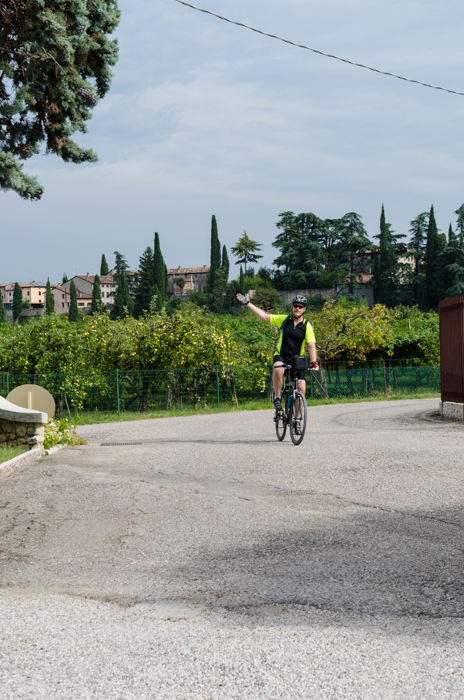 This September, guests on our Bike the Amarone Wine Roads cycling tour enjoyed a private tour and tasting at a wonderful producer of Valpolicella wines, the Brunelli family. The Brunelli name has been closely connected to San Pietro in Cariano, a small valley in the Classic Valpolicella Classico region, whose name derives from the Roman Cariae family. Originally workers on the estate, the family piece by piece purchased this spot in the countryside, and since 1936 have been producing wines here.
This September, guests on our Bike the Amarone Wine Roads cycling tour enjoyed a private tour and tasting at a wonderful producer of Valpolicella wines, the Brunelli family. The Brunelli name has been closely connected to San Pietro in Cariano, a small valley in the Classic Valpolicella Classico region, whose name derives from the Roman Cariae family. Originally workers on the estate, the family piece by piece purchased this spot in the countryside, and since 1936 have been producing wines here.
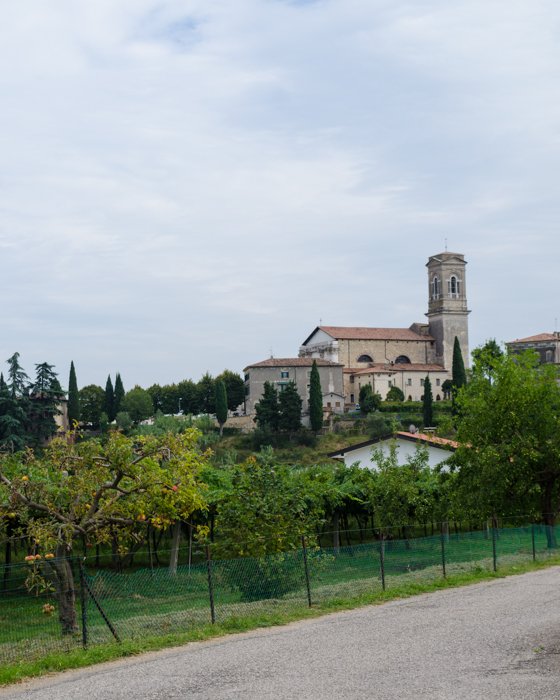 The main objective of the Brunelli Estate is to highlight the typical qualities of the grapes of the Valpolicella area. To quote Alberto Brunelli, “I have discovered, to my surprise, that many wines offer a complex personality. Sometimes it is similar to that of my grandfather; some are more like my father’s character, and yet others offer feminine perfumes and flavors that remind me of my mother and grandmother.” Alberto, in conjunction with his parents Luigi and Luciana, operate the winery today, following the footsteps of past generations.
The main objective of the Brunelli Estate is to highlight the typical qualities of the grapes of the Valpolicella area. To quote Alberto Brunelli, “I have discovered, to my surprise, that many wines offer a complex personality. Sometimes it is similar to that of my grandfather; some are more like my father’s character, and yet others offer feminine perfumes and flavors that remind me of my mother and grandmother.” Alberto, in conjunction with his parents Luigi and Luciana, operate the winery today, following the footsteps of past generations.
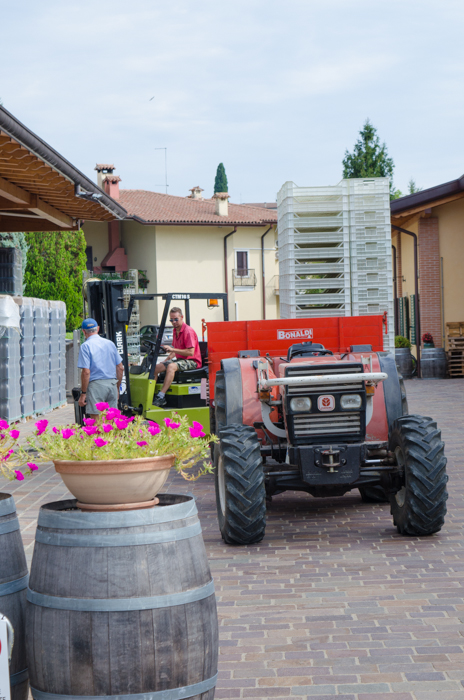 Our tour was in early September, just at the start of the harvest, our timing perfect for gaining insight into the production of one of Italy’s most prestigious wines, Amarone. Amarone wines are produced using the appassimento technique, allowing the grapes to dry before squeezing them to extract the juice. The grapes destined for an Amarone are the last to be picked in this zone, and then spend the next three to four months in drying rooms, being carefully desiccated to avoid mold and rot. The grapes not suitable for drying are pressed immediately and destined for Valpolicella wine.
Our tour was in early September, just at the start of the harvest, our timing perfect for gaining insight into the production of one of Italy’s most prestigious wines, Amarone. Amarone wines are produced using the appassimento technique, allowing the grapes to dry before squeezing them to extract the juice. The grapes destined for an Amarone are the last to be picked in this zone, and then spend the next three to four months in drying rooms, being carefully desiccated to avoid mold and rot. The grapes not suitable for drying are pressed immediately and destined for Valpolicella wine.
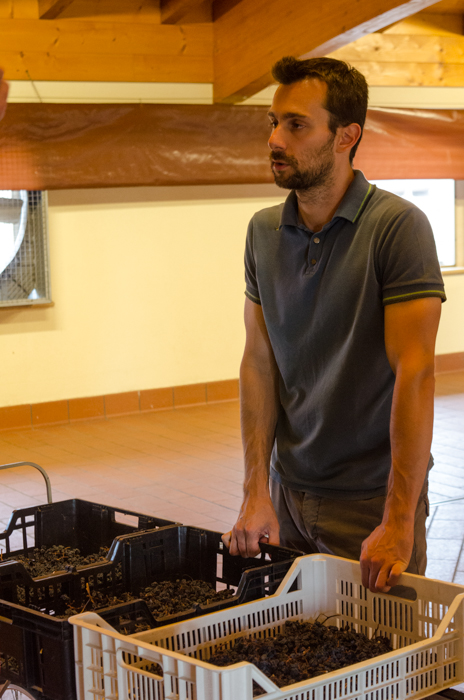 Alberto personally led our tour, and our first stop were the drying rooms. A spacious loft, outfitted with large windows with fans as well as an extensive environmental control system to ensure just the right amount of ventilation and humidity throughout the four month drying process. The first grapes from the harvest were just making their way into these lofts. The grapes are picked by hand, and any with broken skins are eliminated as the grapes must be unblemished in order to dry without rot. The Corvina grape, the predominant grape in Amarone, is thick skinned, and so well-suited for the drying process.
Alberto personally led our tour, and our first stop were the drying rooms. A spacious loft, outfitted with large windows with fans as well as an extensive environmental control system to ensure just the right amount of ventilation and humidity throughout the four month drying process. The first grapes from the harvest were just making their way into these lofts. The grapes are picked by hand, and any with broken skins are eliminated as the grapes must be unblemished in order to dry without rot. The Corvina grape, the predominant grape in Amarone, is thick skinned, and so well-suited for the drying process.
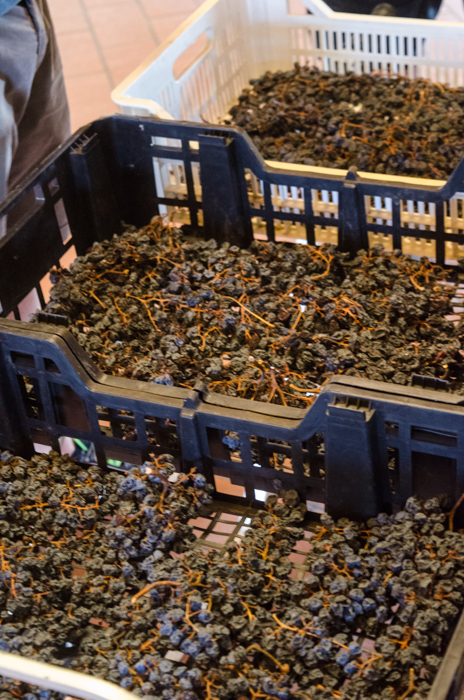 The pristine grapes are carefully laid in a single layer in plastic baskets, which are then stacked on a pallet. At the end of harvest, these plastic baskets fill the loft, extending floor to ceiling. The grapes dry here for 3-4 months, during which they loose 40% of their volume. The grapes are then crushed, and sit on the skins for 40 days, a long slow fermentation at low temperature. allowing the concentrated sugars to convert into alcohol, resulting in Amarone’s characteristic high alcohol level.
The pristine grapes are carefully laid in a single layer in plastic baskets, which are then stacked on a pallet. At the end of harvest, these plastic baskets fill the loft, extending floor to ceiling. The grapes dry here for 3-4 months, during which they loose 40% of their volume. The grapes are then crushed, and sit on the skins for 40 days, a long slow fermentation at low temperature. allowing the concentrated sugars to convert into alcohol, resulting in Amarone’s characteristic high alcohol level.
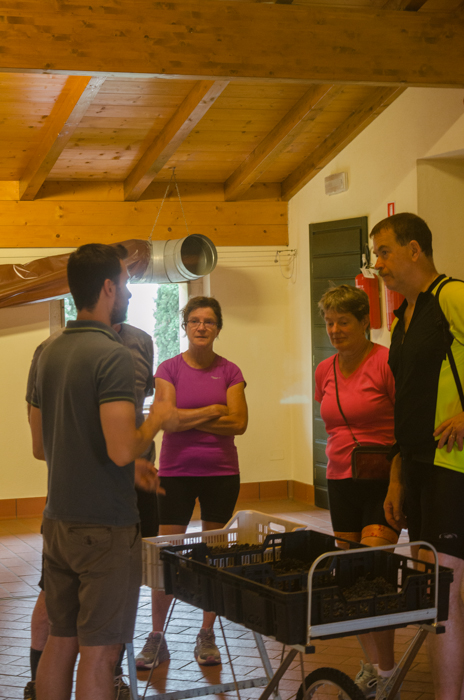 The juice is filtered off, and the wine begins its maturation for two years in barriques and tonneaux. The skins are not done yet, they are given a second role now in the production of Valpolicella “Ripasso”. The skins are then added to Valpolicella wine. These are still impregnated with sugars and yeast cells, and so set off a second fermentation, thus increasing the wine’s level of alcohol, as well as enriching its color, extract and aromas and thus improving its aging potential. The term used to refer to this process, “ripasso”, translates roughly to passing over again.
The juice is filtered off, and the wine begins its maturation for two years in barriques and tonneaux. The skins are not done yet, they are given a second role now in the production of Valpolicella “Ripasso”. The skins are then added to Valpolicella wine. These are still impregnated with sugars and yeast cells, and so set off a second fermentation, thus increasing the wine’s level of alcohol, as well as enriching its color, extract and aromas and thus improving its aging potential. The term used to refer to this process, “ripasso”, translates roughly to passing over again.
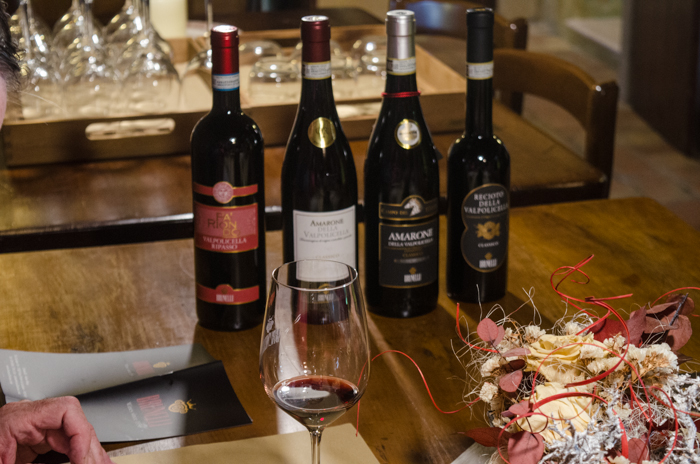 Brunelli makes a broad range of wines under the Valpolicella and Amarone DOC and DOCG regulations, including Valpolicella, Valpolicella Ripasso, and a few different Amarone. After our tour, Alberto guided us to a lovely tasting room where he introduced us to some of the stars of their portfolio.
Brunelli makes a broad range of wines under the Valpolicella and Amarone DOC and DOCG regulations, including Valpolicella, Valpolicella Ripasso, and a few different Amarone. After our tour, Alberto guided us to a lovely tasting room where he introduced us to some of the stars of their portfolio.
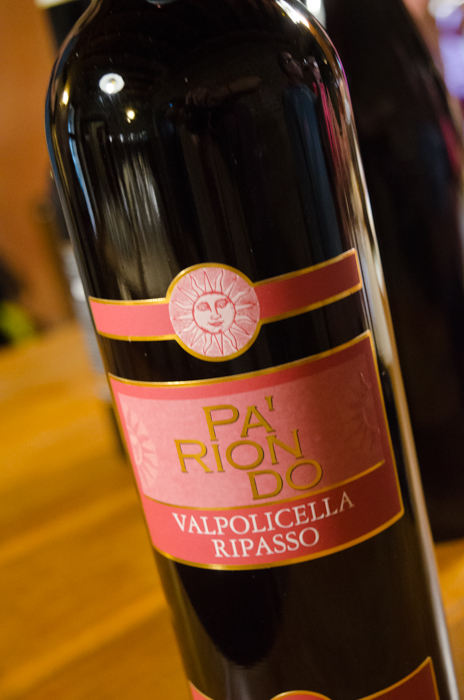 We began with the Pa’ Rionda Valpolicella Ripasso. A blend of Corvina, Rondinella and Corvinone, produced using the traditional Ripasso technique consisting of refermenting a Valpolicella Classico on the skins, still impregnated with sugars and yeast cells, of the semi-dried grapes previously used to make Amarone. It is aged for 12 months in oak and an additional 6 months in the bottel. Intense, with a deep ruby color, well balanced with flavors of currants and blackberries. is an immediately recognizable product of its area of origin.
We began with the Pa’ Rionda Valpolicella Ripasso. A blend of Corvina, Rondinella and Corvinone, produced using the traditional Ripasso technique consisting of refermenting a Valpolicella Classico on the skins, still impregnated with sugars and yeast cells, of the semi-dried grapes previously used to make Amarone. It is aged for 12 months in oak and an additional 6 months in the bottel. Intense, with a deep ruby color, well balanced with flavors of currants and blackberries. is an immediately recognizable product of its area of origin.
Next, their Amarone della Valpolicella. Made from a blend of the same 3 grapes that spent between 3 – 4 months in the drying loft prior to pressing and a 40 day fermentation. The wine is then aged for two years in barriques and tonneaux. After bottling, the Amarone is then kept for at least a further six months in the bottle before being released. Intense red, fruity aroma, and Amarone’s characteristic flavors of currants, berries and cherry. Elegant, well-structured, balanced. Pair with grilled red meats, game, aged cheeses.
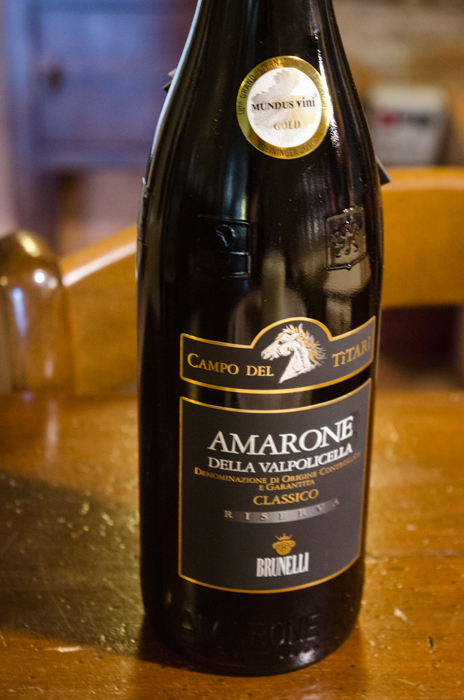 Another Amarone to try – their Amarone della Valpolicella Campo del Tìtari. This special selection of Amarone is produced only in the finest vintages and in very limited quantities. The grapes are very carefully selected through multiple selection stages, a blend of Corvina e Corvinone 75%, Rondinella 15%, and here, a small percentage of Sangiovese 10%. Created to be bold and intense, it displays a deep ruby color. Again aromas of cherries, berries and currants, mingling with vanilla. Robust, nice acidity, and a persistant finish. Alberto shared the origin of the name Campo di Titari, or “Field of Titari” , Titari was the name of the last horse the family owned. Alberto’s father saw similarities between the wine and the horse, both very dark, spicy, lively.
Another Amarone to try – their Amarone della Valpolicella Campo del Tìtari. This special selection of Amarone is produced only in the finest vintages and in very limited quantities. The grapes are very carefully selected through multiple selection stages, a blend of Corvina e Corvinone 75%, Rondinella 15%, and here, a small percentage of Sangiovese 10%. Created to be bold and intense, it displays a deep ruby color. Again aromas of cherries, berries and currants, mingling with vanilla. Robust, nice acidity, and a persistant finish. Alberto shared the origin of the name Campo di Titari, or “Field of Titari” , Titari was the name of the last horse the family owned. Alberto’s father saw similarities between the wine and the horse, both very dark, spicy, lively.
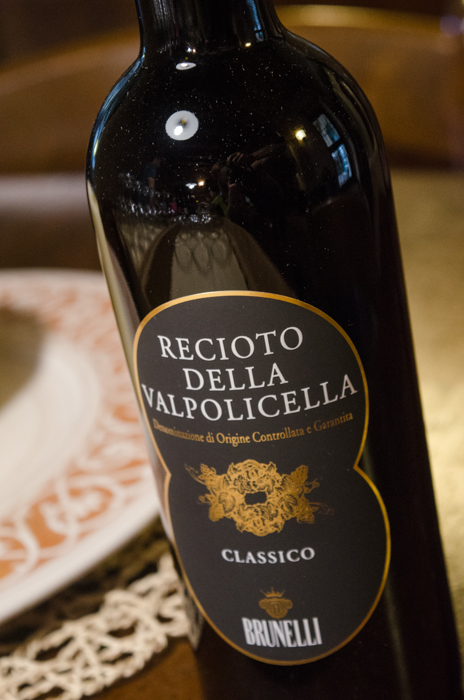 Finally, we ended with the region’s traditional dessert wine, a Recioto della Valpolicella. The name ‘recioto’ comes from ‘recie’, ears in the local dialect. The ‘ears’ of the grape bunch are those lobes on the top, which receive the most sunlight, and are therefore riper and drier, with more concentrated sugars. These are separated from the remainder of the bunch, dried, and are used to produce this sweet dessert wine. A recioto is fermented less time than an Amarone, to retain some sugar for this sweet wine. In fact, legend has it that Recioto is the grandfather of Amarone, as the very first Amarone was produced when someone forgot to stop the fermentation of a Recioto, and all the sugars were consumed. The result was a very dry wine, which when tasted caused the winemaker to exclaim “Amarone”, or very bitter (amaro).
Finally, we ended with the region’s traditional dessert wine, a Recioto della Valpolicella. The name ‘recioto’ comes from ‘recie’, ears in the local dialect. The ‘ears’ of the grape bunch are those lobes on the top, which receive the most sunlight, and are therefore riper and drier, with more concentrated sugars. These are separated from the remainder of the bunch, dried, and are used to produce this sweet dessert wine. A recioto is fermented less time than an Amarone, to retain some sugar for this sweet wine. In fact, legend has it that Recioto is the grandfather of Amarone, as the very first Amarone was produced when someone forgot to stop the fermentation of a Recioto, and all the sugars were consumed. The result was a very dry wine, which when tasted caused the winemaker to exclaim “Amarone”, or very bitter (amaro).
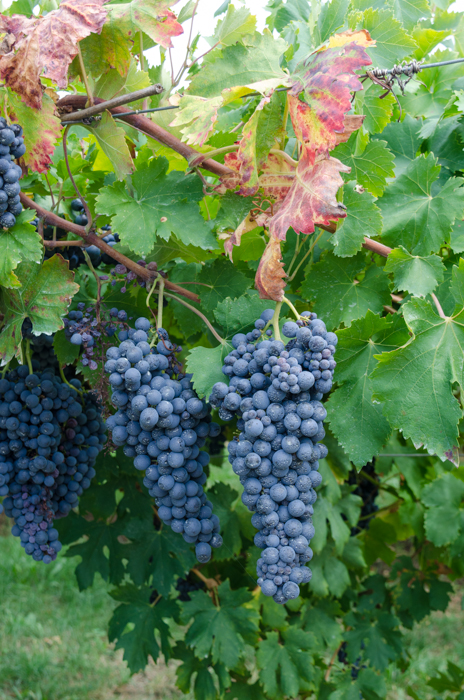 For the Brunelli Recioto, he fermentation process lasts 30 days (rather than 40 for the Amarone) and is arrested by chilling the wine, leaving a substantial amount of residual sugars. The wine then matures in oak barriques for around 8 months, then spends another 6 months in bottle before being released onto the market. Deep red, very aromatic with both floral and fruity notes. Flavors of cherry and raisin, as well as sweet spices and caramel. Complex, full-bodied and robust, enjoy with pastries, nuts, fruit desserts and blue cheeses.
For the Brunelli Recioto, he fermentation process lasts 30 days (rather than 40 for the Amarone) and is arrested by chilling the wine, leaving a substantial amount of residual sugars. The wine then matures in oak barriques for around 8 months, then spends another 6 months in bottle before being released onto the market. Deep red, very aromatic with both floral and fruity notes. Flavors of cherry and raisin, as well as sweet spices and caramel. Complex, full-bodied and robust, enjoy with pastries, nuts, fruit desserts and blue cheeses.
